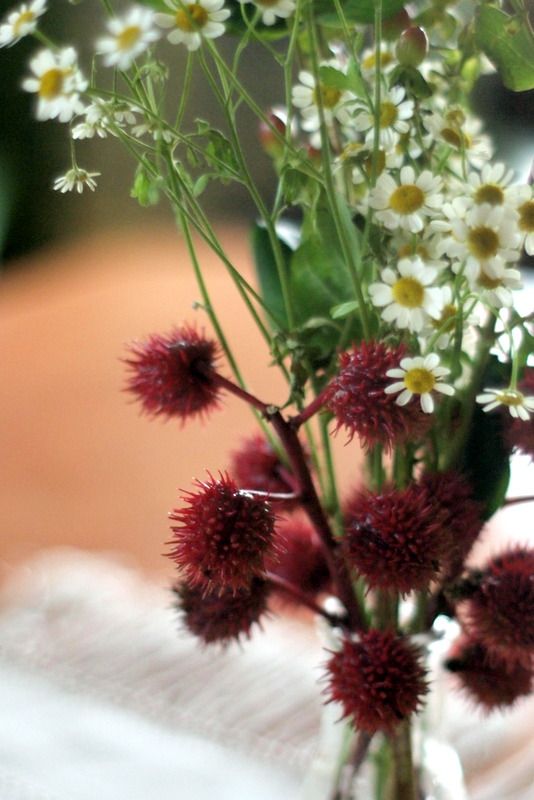The inspiration to include some seed pods from the castor bean plant in leftover Thanksgiving vases already filled with chamomile and hypericum came from this photo from thequintessentialmagazine. Nice touch with the alocasia leaf too.

Like a bloody echinops, the ricinus makes striking cutting material. I suppose it’s the awareness of the castor bean plant’s intensely poisonous properties that prevents me from ever considering it suitable for vases. It’s obviously causing me alliterative fits just talking about it…poisonous properties prevent…

Yet that theory doesn’t really hold water, because the hypericum berries are poisonous too, and I brought those home for vases.
I wonder if any guests would even know that either or both of these plants are poisonous, and if so, would close proximity to them arouse mental discomfort or squeamishness?

And over the holidays we’ll be surrounded, as usual, by toxins amongst all the sparkly lights and baubles. That’s not indulging in bah-humbug sentiments, just talking practicalities. Soon homes will be filled with that other holiday plant suspicious for ill effects when ingested, the poinsettia, though that turns out to be mostly urban legend and not medical fact. Still, it’s a euphorbia, with the typically caustic milky sap that euphorbias possess, that’s known to cause skin rashes. Holly and mistletoe also are reputed to be moderately toxic.

Toxicity issues aside, I think the castor bean seed pods would look amazing in wreaths. Ricinus has naturalized in Southern California, and though many of the seed pods are a dessicated brown this time of year, there’s still lots of bright scarlet pods to pick. The seed pods I picked today are Ricinus communis ‘New Zealand Purple,’ that lives over the winter in my garden, but I bet there’s plants in gardens everywhere that, for whatever reason, just aren’t considered vase-worthy and might be due for a second look. Obviously, use care (gloves?) when handling this kind of plant material for holiday decorations, and site them well away from pets and small kids.

Try to find a plant that isn’t “poisonous”! Lily of the valley…even clematis is feared by some. Certain plants are meant for eating, others not. Just be certain…like with mushrooms.
Those are good examples, ‘bug, and I think that’s a good point, to stay calm and informed. We just had an incident locally of fatalities via poisonous mushrooms tossed into a pot of soup at a nursing home.
One of the funniest discussions I ever encountered on Garden Web was about castor bean. People were actually accusing others of growing “weapons of mass destruction” in their gardens. It was hysterical.
Lovely arrangement…the Castor Bean pods are perfect for the holidays!
What would we oil our castors with if not for castor oil? Wikipedia tells us that castor is Latin for beaver and that before castor oil was discovered in castor beans, it was extracted from the groins of beavers.
“Weapons of mass destruction?” I believe that the second amendment guarantees the right to bear beans. A well regulated (oiled) militia being necessary to the security of a free state, the right of the people to keep and bear castor beans shall not be infringed.
Here unfortunately Ricinus has invaded the local wildlife park, so though I admire it in places where it will not be an invader…we cannot be friends. C’est gardening!
@Sue, I must have been MIA on that WMD discussion. I’ll have to search the GW for it. Sounds like a hoot.
@Scott, they really are. Now if only I can get my act in gear this holiday to do wreaths.
@Peter, you had me laughing at your imaginative flights of fancy, until I wiki’d castor oil too and find you’re not exaggerating! You just can’t make this stuff up! More beans, Mr. Taggart!
Hoov, all the more reason to strip those seed pods from the plants!
I despair of knowing all the dangerous plants – in addition to the obviously spiky ones that can inflict wounds. Hypericum berries? They’re everywhere here.
Hear hear, lets here it for unusual material in vases. love this post Denise